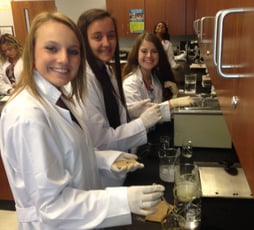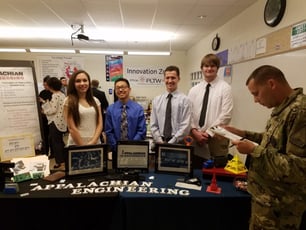Jonas Crooks is a PLTW Engineering teacher at F P Hamilton Career Center in Seneca, South Carolina. He teaches Digital Electronics (DE), Computer Integrated Manufacturing (CIM), Civil Engineering and Architecture (CEA), and Engineering Design and Development (EDD).
The Hamilton Career Center offers an amazing environment for the students of the School District of Oconee County to explore, develop, and hone their skills in a chosen career field.
However, students exploring a career that has traditionally been held by the opposite sex is very uncommon. According to the Census Bureau’s 2009 American Community Survey (ACS), women make up 48 percent of the U.S. workforce, but just 24 percent of STEM workers. This staggering statistic compels the need for nontraditional recruitment in our schools.
Our PLTW program and welding department, led by welding instructor Scott Hightower, teamed up to meet the challenge of recruiting nontraditional learners with our summertime Girls Engineering and Manufacturing (GEM) program. Our target audience is rising 9th- and 10th-grade girls. We promote and recruit for our GEM program through our PLTW teachers, math and science teachers, and guidance counselors.
Our week-long program runs from 8 a.m.-3:30 p.m. with lunch provided. Monday through Thursday, our participants work on projects, and on Friday, we have tours of local industries. We begin each day with an engineering challenge. We have competitions like egg drop contests, spaghetti tower challenges, rubber band car races, levee building contests, and a timed excavator challenge. After our daily challenge, we work on projects dealing with CNC machining, laser engraving, soldering, welding, CNC plasma cutting, and 3-D printing.
We are always striving to come up with new designs and projects for our GEM program. This year's major project was a nightstand. Participants worked in the PLTW lab to design their nightstands using PlasmaCam software and then learned to weld them together. The tops of the project were designed and laser engraved in the PLTW lab, and we assembled and finished them in the welding lab.
Our participants are amazed at the end of the week by how many new skills they have learned and how many different projects they have completed. Two years ago, we accomplished a program landmark when one of our first participants of the GEM program completed every PLTW class that our district offers. She is now completing her degree in mechatronics.
In addition to the other projects, participants each year design a T-shirt for the following year's program, and we also conduct surveys to improve our GEM program for upcoming years.
From our survey, we have learned of ways to market our classes to nontraditional learners and what obstacles prevent them from taking our classes. The obstacles we identified were related to scheduling and stigmas.
The scheduling conflicts are being resolved through closer communication with our feeder high schools. We are a career center that is fed by three high schools, and scheduling is always a challenge. We are identifying classes that are in competition with one another and trying to schedule them accordingly.
The stigmas are tougher. Our participants reported not wanting to be the only girl in a class and reported that they would be interested in taking classes with only girls. We try to schedule girls to take the same class at the same time so that they will not be the only one in a class. As for the girls-only class, we are still trying to see if we can make that happen. Our surveys this year still came back with a strong interest in a girls-only class offering. I believe that we would not have to offer a girls-only program, but instead just offer a level of Introduction to Engineering Design (IED) or another class for girls only. After that initial girls-only class, the students could funnel right back into our regular classes. I believe their confidence levels would be through the roof after one class and that they would have broken through the nontraditional stigma. One class could make the difference of them discovering that this would be a career that they would love, no matter what tradition says.
PLTW’s blog is intended to serve as a forum for ideas and perspectives from across our network. The opinions expressed are those of this guest author.


